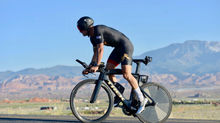Why Switch to a Larger Chainring?
- Jason Lentzke
- Jun 3, 2023
- 3 min read
Updated: Jun 13, 2024
Chainrings are the parts on your bike with the teeth on the chainset over which the chain passes. They are attached to your crankset and you can buy the rings individually.

Rings are supplied with different sizes with different amounts of teeth. The more teeth, the bigger the chainring. The number of teeth affects how much effort is needed to turn the pedals. The larger the chainring, the more rotations of the rear wheel you’ll achieve by a single rotation on the front chainring. Depending on the drivetrain manufacturer (Shimano/SRAM), most newer TT bikes are coming spec'd with 52/36 or 53/39 gear ratios with 10/28-30 cassettes.
So, why go bigger?
Constant Tension: The biggest advantage to riding a bigger chain ring is simply a result of being able to keep tension on the chain at all times: downhill, tailwind, etc. Triathlon bike courses often include long, rewarding descents, but this is not the time to rest. Without a large chain ring, it's not feasible to maintain ideal power and race cadence as you descend. There is no complex calculation needed. If you are regularly pedaling inefficiently with lower power at a very high cadence, you will benefit from having a bigger chainring. Shorter Cranks: A shorter crank length (172.5 to 165) reduces range of motion at the knee (extension and flexion), hips, and low back. It can also reduce restriction through the top of the pedal stroke by opening up an impinged hip angle and/or reducing knee flexion which may allow for an increase in power.
Most riders report that when they switch to a shorter crank their cadence increases. So, when you switch to a shorter crank length you will likely want to increase your chain ring size to match your natural cadence. As Mat Steinmetz points out, "the increase in cadence when moving to a shorter crank length isn’t due to trying to make up for the lack of leverage, but to replicate the foot rate/speed an athlete is accustomed to on a longer crank and to use the extra available O2, which is minimal."
Chain Line: Friction Facts data shows that it’s better to stay in the big chainring for maximum drivetrain efficiency – but not if you are cross chained. Cross-chaining is when you’re in the big chainring and the biggest cog on your cassette, or on your small chainring and your smallest cog. The problem is that this stretches your chain diagonally to its limits. This extreme lateral chain angle makes your drivetrain less efficient as the turns your chain makes become tighter. So, a bigger chain ring can help keep your chain line "straighter" which will reduce chain articulation and give you an incremental efficiency improvement.
Takeaway: Chainrings come in several sizes and combinations, but never settle for what comes "stock" on your TT bike. If you are currently riding a 52/36 and you frequently ride at the lower end (smaller cogs) of your cassette at optimal power, consider transitioning to a 53/39 or 55/42 so you can maintain a cleaner chain line and keep constant tension on the chain at all times.
Choosing a chainring can be difficult. The best way to decide is to try out different sizes until you find the right one for you. Knowing your cadence preference and race course terrain will help you make that decision before you buy, however. Don’t forget about your fitness level either as riding a smaller ring is never a bad thing if you stick to the middle of your cassette.
When the time is right, consult with your mechanic & coach to pair an ideal cassette with your new chainrings.
























Comments